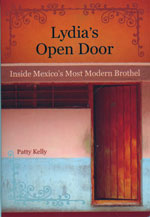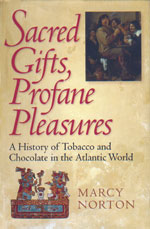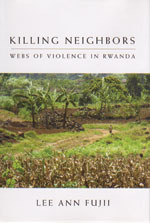Life in “the Zone”
 Hidden in Mexico’s poorest areas, some 140 women go to work each day as legal prostitutes in highly controlled, government-run brothels. In Lydia’s Open Door: Inside Mexico’s Most Modern Brothel (University of California Press, 2008), Patty Kelly, assistant professor of anthropology at GW, details how the political and economic climate of one of Mexico’s poorest states gave rise to the business of brothels.
Hidden in Mexico’s poorest areas, some 140 women go to work each day as legal prostitutes in highly controlled, government-run brothels. In Lydia’s Open Door: Inside Mexico’s Most Modern Brothel (University of California Press, 2008), Patty Kelly, assistant professor of anthropology at GW, details how the political and economic climate of one of Mexico’s poorest states gave rise to the business of brothels.
Dr. Kelly, who spent a year studying and analyzing the brothel Zona Galactica in Tuxtla Gutiérrez, the capital city of Chiapas, Mexico, tells stories of the women who work there to make visible this often-hidden world. Her aim, she writes, is “to uncover and make real for readers the humiliations, despair, illnesses, and even deaths suffered because of an unjust economic system and social beliefs and practices that degrade those occupying the lowest rungs of global society.”
With the eye of an anthropologist, Dr. Kelly examines gender inequality in Mexico’s poorer areas and how social expectations influence behavior. Dr. Kelly also looks at the industry as it operates in the neoliberal era in this poor part of Mexico; explores social stigmas associated with sex workers; details how women negotiate pay and specifics with their clients; and observes how many of the workers see themselves as providing a social service.
The book is a scholarly authority on its subject, but Dr. Kelly also lets the reader get to know some of the women that she meets—their home situations, their humor, and their personalities. While an observer, she is not separate from her study: Dr. Kelly tells of the surprise birthday party thrown for her inside the Zona Galactica and the serenade outside her apartment.
“By regulating and controlling prostitutes, long associated with crime and deviance, the state hoped to discipline sex workers and bring into the formal modern market a sexual-economic activity that has formerly existed outside its control,” she writes.
Dr. Kelly’s research focuses on culture, power, and inequality in Latin America.
New World Pleasures
 A silky-smooth chocolate morsel and a fine puff of tobacco are two guilty pleasures that began a slow infusion around the globe after Europeans landed in the New World. In Sacred Gifts, Profane Pleasures: A History of Tobacco and Chocolate in the Atlantic World (Cornell University Press, 2008), GW professor and historian Marcy Norton describes the cultural and economic importance of these two crops of the Americas as they changed—and were changed—by Europe.
A silky-smooth chocolate morsel and a fine puff of tobacco are two guilty pleasures that began a slow infusion around the globe after Europeans landed in the New World. In Sacred Gifts, Profane Pleasures: A History of Tobacco and Chocolate in the Atlantic World (Cornell University Press, 2008), GW professor and historian Marcy Norton describes the cultural and economic importance of these two crops of the Americas as they changed—and were changed—by Europe.
In an interpretive, substantial, and scholarly text, Dr. Norton describes the delectable history of chocolate and tobacco through varied sources, including artwork, shipping registers, religious treatises, medical manuals, and poetry, to explain how Europeans emulated and adapted American habits into their own social, medical, religious, and economic systems.
Focusing on the Spanish Empire, Dr. Norton examines how the colonizers viewed the two commodities, especially as they began “consuming goods that they knew were so enmeshed in the religious practices of the pagan ‘savages’ they had conquered.”
Dr. Norton also explains the goods’ pre-Columbian roots. Chocolate had social, medicinal, and spiritual importance to Mesoamericans, as did tobacco for Indians throughout the Americas, traditions that stayed with the two goods as they traveled around the world.
The cultural associations and the physiological effects of tobacco and chocolate have persisted—even as they have shifted in form—into how we view and consume the two today, Dr. Norton explains. “In sharing a cigarette or some chocolate (and its successors, coffee and tea), people declare their affection—or at least cordiality—towards one another,” Dr. Norton writes. “‘Let’s have coffee’ more often proposes a low-key, friendly meeting than it suggests the sipping of a bitter brew.”
Dr. Norton is associate professor of history and an expert on the history of chocolate and tobacco. Sacred Gifts won the outstanding book award from the Association for the Study of Food and Society.
Genocide’s Web
 To find answers to the horrific genocide in mid-1990s Rwanda, professor Lee Ann Fujii conducted extensive interviews with Rwandan prisoners and residents from two rural communities. In Killing Neighbors: Webs of Violence in Rwanda (Cornell University Press, 2009), Dr. Fujii uses these inside accounts to show that Hutu killers were influenced by powerful group dynamics to kill Tutsi neighbors, friends, and family.
To find answers to the horrific genocide in mid-1990s Rwanda, professor Lee Ann Fujii conducted extensive interviews with Rwandan prisoners and residents from two rural communities. In Killing Neighbors: Webs of Violence in Rwanda (Cornell University Press, 2009), Dr. Fujii uses these inside accounts to show that Hutu killers were influenced by powerful group dynamics to kill Tutsi neighbors, friends, and family.
“Despite long-standing, mostly amicable relations with their victims, these peasant-killers went about their task in determined fashion…They killed the young and old, the healthy and infirm, men as well as women, mostly Tutsi but thousands of Hutu as well,” Dr. Fujii writes. “How do ordinary people come to commit mass violence against their own neighbors, friends, and family?”
In the book, Dr. Fujii recounts conversations from in-person interviews, often transcribing the questions and answers verbatim. With a thoughtful, thorough, scientific approach, Dr. Fujii examines previously held theories and conclusions, looking at the atrocity of the Rwandan genocide under an anthropological microscope. She examines the gruesome history on a “neighbor level” and looks at individual action rather than sweeping trends. There is little evidence, she writes, that people who joined in the killing hated Tutsi as a group before the genocide.
Such a study may help international authorities head off future genocides.
“[I]f we know mass killers are made, not born, and that large-scale processes of violence hew to local, not just national, dynamics, then we can begin to look for more effective approaches that can disrupt local processes and by doing so, help to avert bloody outcomes,” Dr. Fujii concludes.
Dr. Fujii is assistant professor of political science and international affairs and program coordinator of the international politics cohort of GW’s Women’s Leadership Program.
—Carrie Madren
